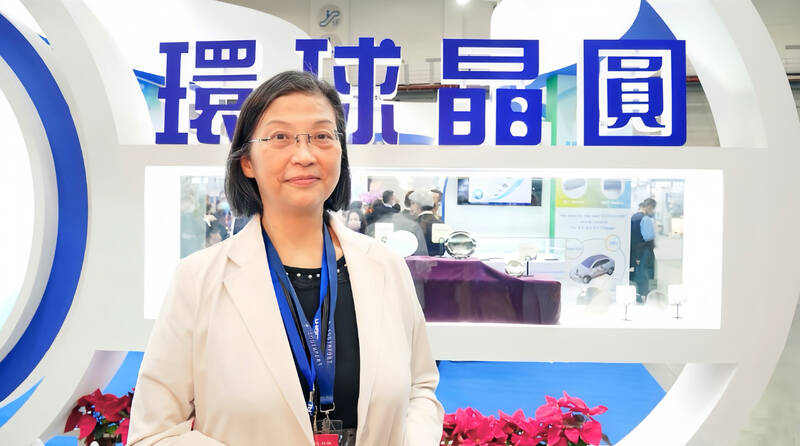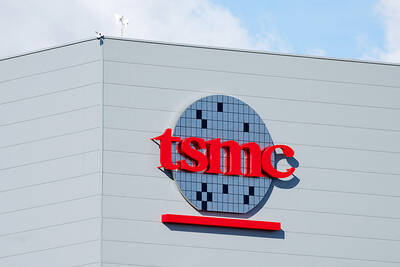GlobalWafers Co (環球晶圓), the world’s No. 3 silicon wafer supplier, yesterday said that revenue would rise moderately in the second half of this year, driven primarily by robust demand for advanced wafers used in high-bandwidth memory (HBM) chips, a key component of artificial intelligence (AI) technology.
“The first quarter is the lowest point of this cycle. The second half will be better than the first for the whole semiconductor industry and for GlobalWafers,” chairwoman Doris Hsu (徐秀蘭) said during an online investors’ conference.
“HBM would definitely be the key growth driver in the second half,” Hsu said. “That is our big hope to make this year’s revenue flat, or slightly better than last year’s. Increases in memory revenue are very important.”

Photo: Fang Wei-chieh, Taipei Times
Growing interest in AI applications has spurred greater demand for advanced epitaxial wafers than GlobalWafers had expected, she said, adding that the company is churning out new capacity to catch up with the high demand.
However, challenges remain, as the company expects a mild recovery in the second half of this year, dragged by customers’ slower-than-expected inventory digestion and softening demand for wafers used in vehicles and industrial devices, the company said.
Revenue this quarter is expected to rise slightly from last quarter, when GlobalWafers’ revenue plummeted 19 percent year-on-year to NT$15.09 billion (US$466.2 million).
“It is still our goal to keep revenue flat compared with last year. I would say that it is challenging because some inventory situations look tough, very sticky and very slow,” Hsu said.
Earthquakes are also a major uncertainty this year, she added.
Since last month’s massive earthquake, measuring 7.2 on the Richter scale, Taiwan has experienced more than 1,300 aftershocks, each of which contribute to production delays, she said.
Nevertheless, GlobalWafers said that earthquakes would have a minimal effect on its revenue this quarter, as it is allocating capacity to other sites to make up for production losses.
The company yesterday reported that net profit in the first quarter fell 29 percent to NT$3.53 billion, compared with NT$5 billion in the first quarter of last year. On a quarterly basis, net profit contracted 20.5 percent from NT$4.44 billion.
Gross margin dropped to its weakest level in about six years at 34.3 percent, compared with 40.6 percent a year earlier and 34.5 percent in the previous quarter.
The company said it would take a few years to improve its gross margin to the key level of 40 percent, as its three-year capacity expansion plans through 2026 would increase equipment depreciation costs in the coming years.
GlobalWafers said it expects depreciation costs this year to surge to between NT$9 billion and NT$10 billion, from NT$6.71 billion last year.
The company also expects a subsidy under the US CHIPS and Science Act and investment credits from the US and other countries to alleviate pressure from depreciation costs, it said, adding that higher equipment utilization would also help.

Taiwan Semiconductor Manufacturing Co (TSMC, 台積電) secured a record 70.2 percent share of the global foundry business in the second quarter, up from 67.6 percent the previous quarter, and continued widening its lead over second-placed Samsung Electronics Co, TrendForce Corp (集邦科技) said on Monday. TSMC posted US$30.24 billion in sales in the April-to-June period, up 18.5 percent from the previous quarter, driven by major smartphone customers entering their ramp-up cycle and robust demand for artificial intelligence chips, laptops and PCs, which boosted wafer shipments and average selling prices, TrendForce said in a report. Samsung’s sales also grew in the second quarter, up

LIMITED IMPACT: Investor confidence was likely sustained by its relatively small exposure to the Chinese market, as only less advanced chips are made in Nanjing Taiwan Semiconductor Manufacturing Co (TSMC, 台積電) saw its stock price close steady yesterday in a sign that the loss of the validated end user (VEU) status for its Nanjing, China, fab should have a mild impact on the world’s biggest contract chipmaker financially and technologically. Media reports about the waiver loss sent TSMC down 1.29 percent during the early trading session yesterday, but the stock soon regained strength and ended at NT$1,160, unchanged from Tuesday. Investors’ confidence in TSMC was likely built on its relatively small exposure to the Chinese market, as Chinese customers contributed about 9 percent to TSMC’s revenue last

With this year’s Semicon Taiwan trade show set to kick off on Wednesday, market attention has turned to the mass production of advanced packaging technologies and capacity expansion in Taiwan and the US. With traditional scaling reaching physical limits, heterogeneous integration and packaging technologies have emerged as key solutions. Surging demand for artificial intelligence (AI), high-performance computing (HPC) and high-bandwidth memory (HBM) chips has put technologies such as chip-on-wafer-on-substrate (CoWoS), integrated fan-out (InFO), system on integrated chips (SoIC), 3D IC and fan-out panel-level packaging (FOPLP) at the center of semiconductor innovation, making them a major focus at this year’s trade show, according

DEBUT: The trade show is to feature 17 national pavilions, a new high for the event, including from Canada, Costa Rica, Lithuania, Sweden and Vietnam for the first time The Semicon Taiwan trade show, which opens on Wednesday, is expected to see a new high in the number of exhibitors and visitors from around the world, said its organizer, SEMI, which has described the annual event as the “Olympics of the semiconductor industry.” SEMI, which represents companies in the electronics manufacturing and design supply chain, and touts the annual exhibition as the most influential semiconductor trade show in the world, said more than 1,200 enterprises from 56 countries are to showcase their innovations across more than 4,100 booths, and that the event could attract 100,000 visitors. This year’s event features 17